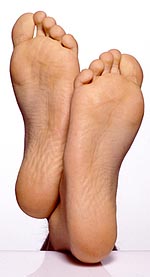Zone Therapy: What Is It and
How Does It Work?

Zone therapy is an alternative healing treatment that is commonly referred to as reflexology. This type of treatment relates to the hand and foot, and involves the practice of adding pressure, via massage, and special pushing and pinching techniques to the hands and feet to trigger specific nerves and organs within the body.
Reflexologists believe that by adding pressure to the nerve endings, they can unblock the energy fields and encourage the healthy flow of energy to the body and vital organs. This type of treatment is done primarily to relieve stress, pain and discomfort within the body.
The hands and feet, and more specifically the fingers and toes are directly connected to nerves within the body; reflexologists apply pressure to these areas, which ultimately gives them a point of access to reach the nerves and vital organs via the zones.
Each finger and each toe represent a specific zone. If you were to look at the body as a diagram, it would be divided up vertically into five zones on either side, left or right. These zones are then "connected" to a specific finger and toe on that side of the body. Each zone also represents a specific organ within the body and on a specific side, and knowing where these zones are, or how to reach them can help relieve pain and discomfort in those areas.
For example, the center zone or line 1 is triggered by the big toes and thumbs at both sides. This zone covers a large number of regions and generally organs that do not have partners. For example, in this zone you will find the brain, thyroid, pituitary, pineal, larynx, trachea, esophagus, thymus, sinuses, nose, tongue, heart, spine, large and small intestine as well as the prostate.
If you were to have any problems or "blocked energy" in any of these areas, a competent reflexologist would be able to assist by unblocking that energy. For example, a throat infection or cold could be released by applying pressure on the big toes or thumbs.
The rest of the lines are further divided by left and right. The second line on the left, which is closest to the center of the body, is triggered by the index finger and the second toe on the left side. This region responds to the brain, lung, heart, eye, adenoids, large and small intestine, pancreas, breast, spleen and the stomach.
The third line on the left is triggered by the middle finger and middle or third toe on the left. This zone responds to the brain, eye, breast, stomach, spleen, pancreas, kidney, small and large intestine, adrenal glands, lung and breast.
The fourth line is triggered by the ring finger and fourth toe on the left, and responds to the brain, eye, large intestine, ovary, lung and breast.
The last line in the left zone, line 5, is triggered via the little finger and baby toe on the left and responds to the ear.
The right zone also has five lines, with the first one starting next to the center zone on the right. The first line is triggered by the right index finger and second toe. This zone corresponds to the brain, lung, breast, small and large intestine, liver and eye.
The third right zone, triggered by the middle finger and third toe on the right, responds to the brain, breast, liver, gall bladder, small and large intestine, adrenal gland, kidney and the eye.
The fourth right zone is triggered by the ring finger and fourth toe on the right. This region responds to the brain, main lymphatic duct, liver, breast, lung, large intestine, ileocecal valve, appendix and the eye.
The last zone in the right is triggered by the pinky finger and baby toe on the right and, like the left, responds to the ear.
While having an understanding of the various zones can help to trigger blocked energy, a competent reflexologist is also familiar with exact pressure points on the palms of hands and soles of feet. By applying pressure to these zones, he or she can more accurately release blocked energy. These zones deal more specifically with individual body parts and can help to relieve pain in the organs as well as areas such as the buttocks and shoulder, et cetera.
|